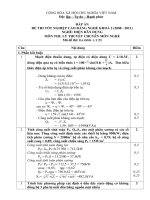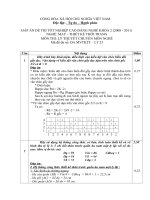PASSAGE 23
Bạn đang xem bản rút gọn của tài liệu. Xem và tải ngay bản đầy đủ của tài liệu tại đây (40.54 KB, 3 trang )
PASSAGE 23
The Association of Southeast Asian Nations or ASEAN was established on 8 August 1967 in Bangkok by
the five original Member Countries, namely, Indonesia, Malaysia, Philippines, Singapore, and Thailand.
Brunei joined on 8 January 1984, Vietnam on 28 July 1995, Lao PDR and Myanmar on 23 July 1997, and
Cambodia on 30 April 1999. The ASEAN Declaration states that the aims and purposes of the Association
are: to accelerate economic growth, social progress and cultural development in the region and to promote
regional peace and stability through abiding respect for justice and the rule of law in the relationship
among countries in the region and adherence to the principles of the United Nations Charter.
In 2003, the ASEAN Leaders resolved that an ASEAN Community shall be established comprising three
pillars, namely, ASEAN Security Community, ASEAN Economic Community and ASEAN SocioCultural Community.
The ASEAN Vision 2020, adopted by the ASEAN Leaders on the 30th Anniversary of ASEAN, agreed on
a shared vision of ASEAN as a concert of Southeast Asian nations, outward looking, living in peace,
stability and prosperity, bonded together in partnership in dynamic development and in a community of
caring societies. ASEAN Member Countries have adopted the following fundamental principles in their
relations with one another, as contained in the Treaty of Amity and Cooperation in Southeast Asia (TAC):
mutual respect for the independence, sovereignty, equality, territorial integrity, and national identity of
all nations;
the right of every State to lead its national existence free from external interference, subversion or
coercion;
non-interference in the internal affairs of one another;
settlement of differences or disputes by peaceful manner;
renunciation of the threat or use of force; and
effective cooperation among themselves.
Question 1. According to the text, which nation is the last member to join The Association of Southeast
Asian Nations up to now.
A. Vietnam
B. The Philippines
C. Brunei
D. Cambodia
Question 2. The ASEAN Declaration is about _______.
A. the cultures of all the members of the organization
B. the development of all countries allover the world
C. the aims and purposes of the organization
D. the laws of the members of the organization
Question 3. The third paragraph is about _______.
A. living in peace, stability and prosperity
B. the 30th Anniversary of ASEAN
C. The ASEAN Vision 2020
D. the ASEAN Leaders
Question 4. The Treaty of Amity and Cooperation in Southeast Asia _______.
A. is not accepted by ASEAN Member Countries
B. consists of fundamental principles in the relations of ASEAN Member Countries
C. is disapproved by ASEAN Member Countries
D. has two principles
Question 5. Which principle does not belong to the Treaty of Amity and Cooperation in Southeast Asia?
A. interference in the internal affairs of member countries
B. effective cooperation
C. mutual respect
D. peaceful manner
ĐÁP ÁN
1-D
2-C
3-C
4-B
5-A
LỜI GIẢI CHI TIẾT
Question 1:
Câu hỏi : Theo văn bản, quốc gia nào là thành viên cuối cùng tham gia Hiệp hội các Quốc gia Đông Nam
Á đến nay.
Đáp án là D. Campuchia
Thông tin nằm ở : “Brunei joined on 8 January 1984, Vietnam on 28 July 1995, Lao PDR and Myanmar
on 23 July 1997, and Cambodia on 30 April 1999.”
Question 2:
Câu hỏi : Tuyên bố ASEAN là về
Đáp án là C. Mục đích và mục đích của tổ chức
Thơng tin nằm ở : “The ASEAN Declaration states that the aims and purposes of the Association are:”
Question 3:
Câu hỏi : Đoạn thứ 3 nói về
Đáp án là C. Tầm nhìn ASEAN
Question 4:
Câu hỏi : Hiệp ước Thân thiện và Hợp tác ở Đông Nam Á _______.
Đáp án là B: Bao gồm các nguyên tắc cơ bản trong quan hệ giữa các nước thành viên ASEAN
Thông tin nằm ở : “ASEAN Member Countries have adopted the following fundamental principles in
their relations with one another, as contained in the Treaty of Amity and Cooperation in Southeast Asia
(TAC):”
Question 5:
Câu hỏi : Nguyên tắc nào không thuộc Hiệp ước Thân thiện và Hợp tác ở Đông Nam Á?
Đáp án là A. Can thiệp vào công việc nội bộ của các nước thành viên Thông tin nằm ở : “ASEAN
Member Countries have adopted the following fundamental principles in their relations with one another,
as contained in the Treaty of Amity and Cooperation in Southeast Asia (TAC):
mutual respect for the independence, sovereignty, equality, territorial integrity, and national identity of
all nations;
the right of every State to lead its national existence free from external interference, subversion or
coercion;
non-interference in the internal affairs of one another;
settlement of differences or disputes by peaceful manner;
renunciation of the threat or use of force; and
effective cooperation among themselves.”
BÀI DỊCH
ASEAN được thành lập vào ngày 8 tháng 8 năm 1967 tại Bangkok bởi 5 nước thành viên ban đầu là
Indonesia, Malaysia, Philippines, Singapore và Thái Lan. Brunei đã tham gia vào ngày 8 tháng 1 năm
1984 tại Việt Nam vào ngày 28 tháng 7 năm 1995, Lào và Myanmar vào ngày 23 tháng 7 năm 1997 và
Campuchia vào ngày 30 tháng 4 năm 1999. Tuyên bố ASEAN nêu rõ mục tiêu và mục đích của Hiệp hội
là đẩy nhanh tốc độ tăng trưởng kinh tế, Và phát triển văn hố trong khu vực và thúc đẩy hịa bình và ổn
định khu vực thông qua việc tôn trọng công lý và pháp quyền trong mối quan hệ giữa các quốc gia trong
khu vực và tuân thủ các nguyên tắc của Hiến chương Liên hợp quốc.
Năm 2003, các Nhà Lãnh đạo ASEAN quyết tâm thành lập Cộng đồng ASEAN bao gồm ba trụ cột, đó là
Cộng đồng An ninh ASEAN, Cộng đồng Kinh tế ASEAN và Cộng đồng Văn hoá-Xã hội ASEAN.
Tầm nhìn ASEAN năm 2020, được các nhà lãnh đạo ASEAN thông qua vào ngày kỷ niệm 30 năm
ASEAN, đã nhất trí về tầm nhìn chung về ASEAN như một buổi hịa nhạc của các quốc gia Đơng Nam Á,
hướng ngoại, sống trong hịa bình, ổn định và thịnh vượng, kết hợp cùng nhau trong sự phát triển năng
động Và trong một cộng đồng các xã hội chăm sóc.
Các nước thành viên ASEAN đã thông qua các nguyên tắc cơ bản sau đây trong mối quan hệ với nhau
như trong Hiệp ước Thân thiện và Hợp tác ở Đông Nam Á (TAC):
tôn trọng lẫn nhau về độc lập, chủ quyền, bình đẳng, tồn vẹn lãnh thổ, và bản sắc quốc gia của tất cả
các quốc gia;
quyền của mỗi quốc gia dẫn dắt sự tồn tại của quốc gia khỏi bị can thiệp, lật đổ hoặc cưỡng bức bên
ngồi;
Khơng can thiệp vào công việc nội bộ của nhau;
giải quyết các bất đồng hoặc tranh chấp bằng cách hịa bình;
từ bỏ mối đe dọa hoặc sử dụng vũ lực; Và
hợp tác hiệu quả với nhau.









